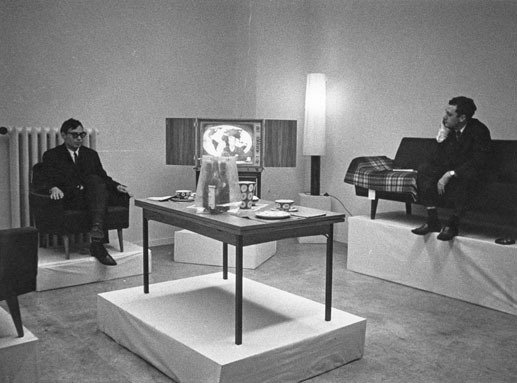Living With Pop
dal 20/7/2013 al 28/9/2013
Segnalato da
Gerhard Richter
Konrad Lueg
Sigmar Polke
Manfred Kuttner
Christopher Williams
Elodie Evers
Magdalena Holzhey
Gregor Jansen
20/7/2013
Living With Pop
Kunsthalle Dusseldorf, Dusseldorf
A Reproduction of Capitalist Realism. The present show is not only occasioned by the 50th anniversary of the coining of this term in 2013 but also especially by the fact that this important phenomenon has yet to be the subject matter of comprehensive exhibition project.

Curated by Elodie Evers, Magdalena Holzhey
Gerhard Richter, Konrad Lueg, Sigmar Polke and Manfred Kuttner
With a contribution by Christopher Williams
The Kunsthalle Düsseldorf is planning a large exhibition project on Capitalist Realism for late summer 2013. Gerhard Richter, Konrad Lueg, Sigmar Polke and Manfred Kuttner coined this term in early 1963 on the occasion of the exhibition they organised themselves in a vacant shop on Kaiserstraße 31a in Düsseldorf. Although they used it only for a brief while and later distanced themselves from the perception that they made up an artists’ group, Capitalist Realism represents a specific West German approach to art during the post-war period and is still controversially debated today: Irony? Marketing strategy? Art movement? Social criticism? Was it Fluxus? What is concealed behind the myth associated with the Capitalist Realism label?
The present show is not only occasioned by the 50th anniversary of the coining of this term in 2013 but also especially by the fact that this important phenomenon has yet to be the subject matter of comprehensive exhibition project. Focus is placed on the 1963 action Life with Pop – Demonstration for Capitalist Realism, which Gerhard Richter and Konrad Lueg organised at the Berges Furniture Store in Düsseldorf, as well as the so-called front yard exhibition at Galerie Parnass in Wuppertal in addition to other group actions and shows like Homage to Schmela, polke/richter at Galerie h in Hannover and the exhibitions put on by René Block. Block, who was fascinated by the possibilities offered by a renewed artistic exploration of reality, employed the term Capitalist Reality when he founded his first Berlin gallery in 1964 as a leitmotif-like key word for his activities, politicising it in the process against the historical backdrop of the division of Germany. A further section of the exhibition is devoted to the decisive influence that the Rhenish Fluxus movement had on the Capitalist Realism actions.
The show documents the historical actions and presents all of the artworks relevant for Capitalist Realism that were shown at that time in the form of reproductions. This deliberate forgoing of originals makes sense in many respects within the framework of the present exhibition. The artists themselves declared in the press release for the Kaiserstraße action that painting is a moral act and that they were not concerned with painting good pictures. Analogous to American Pop Art, they rejected a metaphorical and expressive style. They instead turned to the trivial in their own immediate environment, documenting aspects of contemporary history in the process: the post-war German economic miracle and the associated consumer goods, private and political portraits, petit bourgeois homes, holiday destinations and competition are just a few of the themes that make up the specific Capitalist Realism iconography. A common aspect of Richter’s, Polke’s and Lueg’s works is the fact that they do not depict the objects or subject matters themselves, but are reproductions of them instead that were for example taken from newspapers and magazines and also identified as such by the selection of their techniques and picture details.
The artists had an obvious ambivalent relationship to the term Capitalist Realism they had coined. On the one hand they clearly spelled out a critical reflective view of social conditions with it, but they also skilfully took advantage of capitalist marketing strategies on the other by constructing a distinctive persona for themselves, hence accelerating their own market value. The art movements appearing on the invitation to the action at the Berges furniture store can for example be read like a stringing together of labels in the service of positioning and marketing.
Furnished with a question mark, the artist equally called their own significance into question, pointing with sly pragmatism to the art market and the persistent demand – Capitalist Realism – to create new things. The fact that the most important actions were carried in shops or businesses will also be reflected in the exhibition architecture to be realised by the Berlin architects Kühn Malvezzi. The show will consequently not only examine the historical significance of this brief but groundbreaking phenomenon but will also be revived by means of one of its own formats in the collaboration with Christopher Williams. Working with reproductions conveys in this conjunction a better understanding of the concerns the artists had at that time by not permitting the reception of the artwork to be influenced by the aura of the unique original. On the other hand it also enables a completely independent way of dealing with the exhibits, offering new insights into the early works by the protagonists that were made under very different auspices than their later works.
A comprehensive publication published by the Verlag der Buchhandlung Walther König will appear on the occasion of the exhibition.
Press and Communication
Dirk Schewe Tel.: +49 (0)211 8996256 Fax: +49 (0)211 8929576 presse@kunsthalle-duesseldorf.de
Kunsthalle Düsseldorf
Grabbeplatz 4 D-40213 Düsseldorf
Hours: Tuesday – Sunday, public holidays: 11 am – 6 pm
Entrance: Adults EUR 5,50 Concessions EUR 3,50 Groups (10 or more) EUR 3,50
Disabled free Young persons under age 18 free



